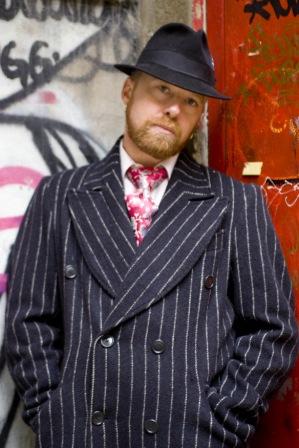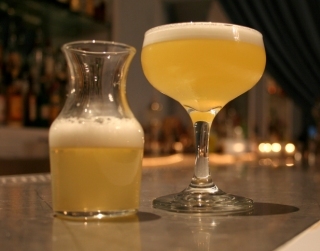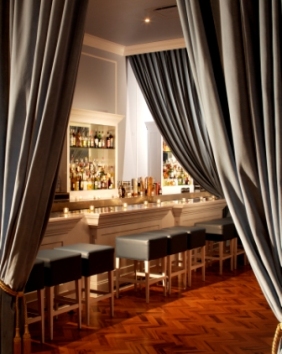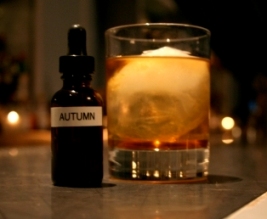Interview: Toby Maloney, The Violet Hour
By Karl Klockars in Food on Oct 3, 2008 6:05PM
 Toby Maloney calls it a “crazy year,” but it's been over a year since he opened up The Violet Hour, the now-famous bar with no sign, no cellphones, no smoking (pre-ban) and some of the finest drinks that Chicago has ever seen. With a focus on fresh-squeezed juices, homemade syrups and bitters, and an excellent array of fine spirits with an emphasis on gin, rum and rye – no vodka at the outset – VH was the kind of place you either loved instantly, or just didn’t get it.
Toby Maloney calls it a “crazy year,” but it's been over a year since he opened up The Violet Hour, the now-famous bar with no sign, no cellphones, no smoking (pre-ban) and some of the finest drinks that Chicago has ever seen. With a focus on fresh-squeezed juices, homemade syrups and bitters, and an excellent array of fine spirits with an emphasis on gin, rum and rye – no vodka at the outset – VH was the kind of place you either loved instantly, or just didn’t get it.
You mean I can’t get a vodka tonic? A Bud Light? A Cosmo on demand? While these limitations seem to shatter the hearts of dozens of Yelpers, the answer is: No, you can’t. And you should be thankful – rather, you’re going to have an Iron Cross, a Blue Ridge Manhattan, a Juliet & Romeo, and it will very likely change your mind on what can be done with a bottle of booze.
On our first visit, we wandered through the gin and whiskey drinks on the menu – “Doesn’t get much better than that,” says Maloney. “When one person orders whiskey and the other person orders gin, you know you’re going to have a good time at the Violet Hour,” he says, and we can’t disagree with that statement whatsoever.
Toby Maloney spent a few minutes with us while he was in the wilds of greater New York to discuss bartender injuries, his feelings on the whole “ice program” thing, and why he drinks High Life.
Chicagoist: Your style of hyper-intense cocktail was pretty new to the city when you opened. Now that Violet Hour has been a year in business, have you started to notice any influence you might have had in Chicago?
Toby Maloney: I can tell you that all of my bartenders have been approached by people who are opening a new bar and they want my bartenders to come work for them! I’ve seen a lot of that. And I’ve seen places that are doing cocktail things a little bit more than they did before in Chicago. But I think it’s an evolution that was bound to happen because the cocktail thing has been so big on the coasts for the last ten years, and now it’s slowly going toward the middle of the country.
 C: Is that part of the reason why you picked Chicago as where you wanted to open the Violet Hour?
C: Is that part of the reason why you picked Chicago as where you wanted to open the Violet Hour?
TM: Well, how it happened was…I used to live in Chicago and worked for [Violet Hour partner] Terry Alexander. Then I moved [to New York] and over about the next ten years, Terry Alexander walked into every single bar that I was working at. And about 2 years ago he came into the bar I was working at and he goes, “All right, obviously we both like the same thing…we should really sit down and talk.” And that’s the impetus where the Violet Hour started. And then I thought about Chicago and it’s such a great food town and it has so much going on with that, that it just makes total sense to open something in Chicago.
C: I wanted to ask you about one thing that people seemed to really harp on when you opened – the dozen different kinds of ice that Violet Hour has. Are you done hearing about it yet, or is that the kind of thing that people still concentrate on if they want to accuse you of being too pretentious?
TM: You know, I can’t help what other people think about things. I don’t feel that our ice program – and I know it sounds pretentious to even have an ice program – but what we do all those things for is a specific reason. And it’s not to be pretentious. It’s that the quality of the ice and the temperature of the ice all goes toward what I think makes a better cocktail.
We say [that] ice is to a bartender, what a stove is to a chef. But chefs rarely have to talk about how their ovens and their stoves and their convection ovens work, because it’s just known. Whereas the ice thing is a new concept for most people, because it’s never been seen before.
I’m sorry people that think it’s pretentious, but you can’t make everybody happen all the time, and I still stand behind what we do with our ice and our spirits, and know that we don’t have cranberry juice. We’re not a bar for everybody every day of the week. I hope that when people come and try to have something like that, I know my bartenders do their very best to get them something that is as good, if not better, than what they ordered.
The staff at the Violet Hour are such an amazing group of people who are so knowledgeable, and friendly and courteous and professional that I feel good about making those choices that someone might think are pretentious, but I don’t think they are.
 C: Do you still have people coming in and ordering a Bud Light?
C: Do you still have people coming in and ordering a Bud Light?
TM: Yeah, definitely. Especially on Friday and Saturday nights - In every bar across America, there are people that come in and are expecting something and they don’t get what they are looking for. And it’s a sad thing, but hopefully if we can bring some people to appreciate other things in their life, then I think we’re doing well.
C: I’ve been following some of your posts on LTHForum where you provide recipes for a good number of your drinks. I was impressed with the kind of openness that demonstrated, when arguably the uniqueness of your drinks is your bread and butter, your life’s blood.
TM: You know, at this point…well, it’s a couple of things. Since I started bartending here in New York, a couple of years ago the bartenders were always really excited when they came up with something and they were spreading the good word because it was a lot more in its infancy. And so if you had a question about how to make that one drink, that person would always be happy to give you the specs right then and there or even write them down for you.
Because most bartenders at this point can reverse engineer any drink. They might have a hard time with things like house-made syrups or bitters, but they could get a really close approximation. So it seems like hoarding those recipes seems very mean, and stingy. That’s not the life’s blood. The life’s blood is what you’ve done up until that point, but the really good stuff is where you’re going – that’s how I look at it. That’s my base of all the things that I’ve done so far, but I’m still evolving, still working, still doing other things. So I don’t really have a problem giving out recipes.
 I probably wouldn’t for my bitters, because that’s proprietary. And there’s always a possibility of selling those eventually. But I’ve also done bitters classes, and talked to people [on] how to make them. But I find that there’s a couple twists and turns that I do to my bitters that aren’t intutitive, and so I’m keeping those close to the vest.
I probably wouldn’t for my bitters, because that’s proprietary. And there’s always a possibility of selling those eventually. But I’ve also done bitters classes, and talked to people [on] how to make them. But I find that there’s a couple twists and turns that I do to my bitters that aren’t intutitive, and so I’m keeping those close to the vest.
C: That was my next question – I’m sure a lot of home bartenders would love to get their hands on your bitters. Have you looked into retailing?
TM: I would love to. It’s a long, arduous process getting FDA approval. I just talked to some people here in New York who just went through the process and it’s pretty crazy. I would always love to do that, but it’s such a massive project that I don’t really have time to devote myself solely to that.
C: The other day I watched the videos the Reader's Food Chain blog has posted of how you make some of your drinks – are you worried about the possibilities of repetitive stress injuries?
TM: I have really severe tendonitis in one elbow, and I ripped all my ligaments in one of my shoulders. My knees are pretty well shot. So…yeah. I don’t need to worry about that because it’s already happened.
I’ve been in the service industry since 1980, running around bussing tables or washing dishes or waiting tables – 30 years on your feet is going to take a toll on your body. But it’s also kept me young in many other ways. I notice that in some of the people who come to me, when I watch them shake, I tell them about those things and steer them away from things that are obviously going to hurt them quicker than others.
So, I do worry about it in other people, and I try my best to coach people through their shakes. Because everybody’s is different. But learning the proper way to do it, and the proper way that’s going to be easiest on their joints is definitely important.
C: The pistoning of the shoulders, the stance, the gradual buildup of speed…that’s all a style that’s been built over years of experience.
TM: Yeah. Exactly. And still, for years I wore a brace on my elbow because my tendonitis was so bad, I couldn’t work an entire shift without wearing a big sports brace on it. And now I shake a lot less, but I can tell – if I do a full 8 hour shift I feel it the next day. Definitely.
C: At this point, are there any plans to open any similar places elsewhere?
TM: There are no plans to take Violet Hour anywhere else right now, but we’ve only been open a year, and it’s an evolving sort of thing. I would love to - it’s a very interesting thing to try to create your vision in different places because it’s always going to be different. It’s never going to be exactly the same because of staffing, because of the space itself, because of many different things.
I would love to open up places all over in the same model, you know – high end cocktails with good ice and fresh squeezed juices – because it’s always a great intellectual enterprise for me to try to figure out those problems and solve them.
C: Tell me – when was the last time you had a High Life?
TM: Two days ago. That’s my beer of choice.
C: Do people just assume that you only drink the finest of high-end things since you run a place like Violet Hour? I remember reading that you do enjoy a nice High Life from time to time.
TM: I do. I appreciate lots of different things. Most of the high end bartenders I know usually drink – and I definitely do this as well – drink really good spirits, either neat or with a little tiny bit of ice, and a really bad beer. The bad beer is just to cleanse your palate between sips of really good spirits.
Whereas if you spend your life thinking about cocktails, or writing about cocktails, and then making cocktails and doing everything about cocktails, kind of the last thing you want to do at the end of the day is have a cocktail.
C: See, now I don’t even really consider High Life a bad beer…but when we start talking about Milwaukee’s Best or a can of Hamms…
TM: It depends – I’ve enjoyed a can of Hamms a few times in my life! There’s a time and a place for everything. I never try to force what I want to eat or drink on where I am – I always go out of my way to ask the people who work there, “What should I be having at this particular point.” Because obviously, you can tell, if you’re at a beer bar you order beer. If it’s a high-end cocktail bar, you order a cocktail.
But at the same time, at the end of the night, those little babies of Miller High Life and a Methusalem, which is a kind of Dominican Rum, is really exactly what I want to drink.
The Violet Hour is located at 1520 N. Damen. Photographs courtesy of Matthew Martinez, and Michael Robinson Photography.